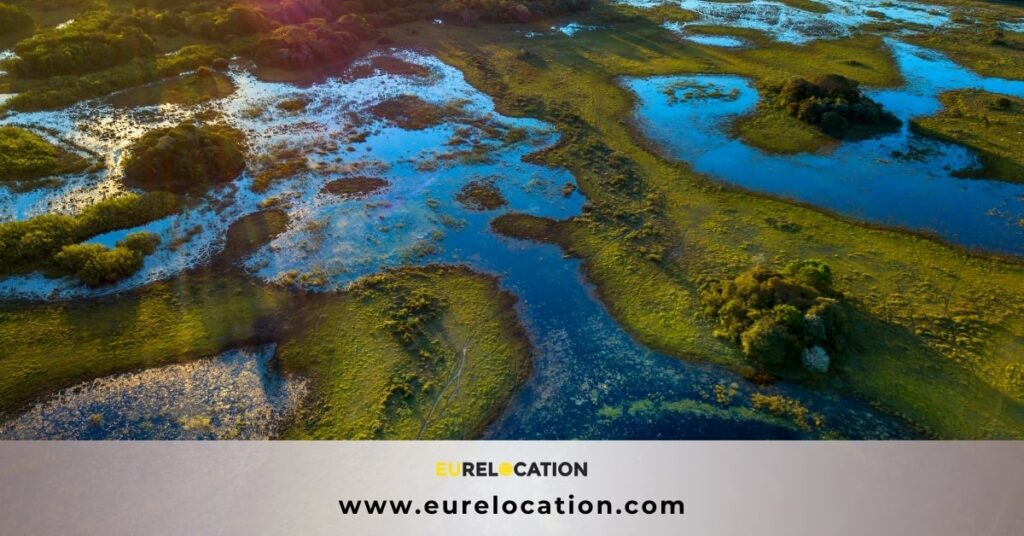Biodiversity in Europe is a priority for the continent, as it faces increasing threats from urbanisation, pollution, climate change, and habitat degradation. European countries, both large and small, are committed to preserving biodiversity in Europe through comprehensive conservation strategies. These efforts span from the EU’s overarching initiatives to national and local projects. Europe is leveraging its resources to protect and restore ecosystems, habitats, and species.
1. The European Union’s Role in Biodiversity in Europe Conservation
The European Union plays a leading role in conservation through funding, legislation, and fostering cooperation among member states. Two critical initiatives are Natura 2000 and the EU Biodiversity Strategy for 2030.
- Natura 2000: This is the world’s largest coordinated network of protected areas. It covers over 18% of EU land and 9% of marine areas. Natura 2000 safeguards nearly 2,000 rare and threatened species. It ensures balanced protection while allowing sustainable human activities.
- EU Biodiversity Strategy for 2030: This strategy aims to protect 30% of Europe’s land and marine areas. Ten percent of these areas will be under strict protection. Other goals include planting three billion trees, reducing pesticide use, and restoring 25,000 km of rivers. These measures will enhance ecosystem resilience across the continent.
2. Germany’s Biodiversity in Europe Commitments
Germany has long emphasized biodiversity protection through policies that involve both government and community support.
- National Biodiversity Strategy: Launched in 2007, this strategy promotes sustainable biodiversity use. It aims to protect 30% of Germany’s forests and increase organic agriculture on 20% of arable land.
- Biosphere Reserves: Germany’s 16 UNESCO biosphere reserves, like the Rhön and Black Forest, combine sustainable development with conservation. These reserves balance farming, tourism, and environmental stewardship.
3. France’s Conservation Initiatives for Biodiversity in Europe
France’s diverse ecosystems, from coastal areas to mountains, are protected under robust conservation policies.
- French Biodiversity Plan: Launched in 2018, this plan includes key measures such as banning neonicotinoid pesticides. It also creates new nature reserves and expands marine biodiversity protection. France aims to protect 30% of its territories by 2030.
- Marine Conservation: France’s expansive marine areas, including overseas territories, have significant protected zones. These zones help preserve marine ecosystems from the Caribbean to the Pacific.
4. Spain’s Biodiversity in Europe Strategy
Spain, with vital ecosystems for avian biodiversity, has implemented various strategies to support wildlife.
- Spain’s Biodiversity Strategy 2030: This strategy focuses on protecting migratory bird habitats. It also prevents wildlife trade and manages invasive species. Spain aims to conserve 30% of its land by 2030, in line with EU goals.
- National Parks and Protected Areas: Spain’s national parks, such as Doñana and Sierra de Guadarrama, play a key role in conserving bird and mountain habitats. These areas benefit avian populations and other species.
5. The United Kingdom’s Efforts
The UK is dedicated to habitat restoration and rewilding, aiming to improve natural ecosystems.
- Biodiversity Net Gain Policy: This policy mandates that new developments improve local biodiversity. It supports both urban and rural ecosystems through habitat restoration.
- Rewilding Projects: Known for rewilding efforts, the UK has seen projects like the Knepp Estate. This initiative supports species reintroduction, including bison, lynx, and beavers. These species help revitalize local biodiversity.
6. Scandinavia’s Conservation Leadership
Scandinavia, comprising Sweden, Norway, and Finland, leads in sustainable resource management and biodiversity conservation.
- Sweden’s Environmental Objectives: Sweden’s 16 environmental objectives include biodiversity protection. The country aims to protect 30% of land and water areas by 2030. Sweden also maintains old-growth forests to preserve biodiversity.
- Norway’s Marine Conservation: Norway focuses on sustainable fishing in the Arctic, particularly in the Barents Sea. This approach helps conserve species like cod and orca.
7. Italy’s Focus on Habitat and Species Protection
Italy’s biodiversity-rich ecosystems, spanning Mediterranean coasts and mountainous regions, are supported by a robust protected areas network.
- Protected Areas Network: Italy’s national parks and marine reserves, like Gran Paradiso and Cinque Terre, protect habitats. These reserves promote eco-friendly tourism, raising awareness and supporting local communities.
- Green Infrastructure: Italy invests in wildlife corridors and green infrastructure to connect fragmented habitats. This approach fosters greater ecosystem connectivity.
8. Malta’s Distinctive Biodiversity in Europe Initiatives
Despite its small size, Malta prioritizes biodiversity conservation, especially given its Mediterranean climate and unique species.
- Natura 2000 Sites: Malta designates significant land and marine areas as Natura 2000 sites. These areas protect essential habitats for local and migratory species. Key sites like Għadira Nature Reserve and Majjistral Nature Park support bird populations and endemic plant species.
- Marine Conservation: Malta’s marine protected areas (MPAs) cover over 35% of its coastal waters. These MPAs help species such as the dusky grouper and loggerhead turtle.
- National Biodiversity Strategy and Action Plan (NBSAP): Malta’s NBSAP outlines strategies to expand protected areas, restore habitats, and promote sustainable tourism. Public education is a major component, engaging local schools and communities in conservation activities.
Protecting Biodiversity in Europe for Future Generations
Biodiversity in Europe is protected through a coordinated effort involving EU policies, national strategies, and local initiatives. While individual countries adapt their approaches to meet unique ecological challenges, shared goals—such as the EU’s target to protect 30% of land and marine areas by 2030—help unify conservation across borders. Challenges like climate change, urbanisation, and invasive species require sustained commitment. However, Europe’s comprehensive strategies continue to advance biodiversity conservation and resilience. This ensures the continent’s natural heritage is secured for future generations.









